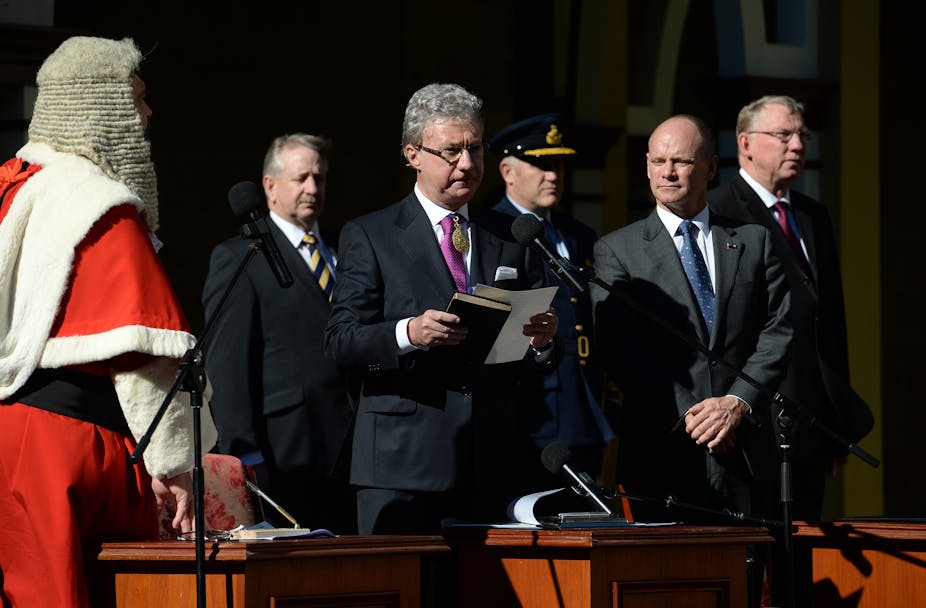Labor has claimed Queensland’s caretaker premier, Campbell Newman, must resign “by 6.01pm” tonight, while Liberal National leader Lawrence Springborg has claimed his party has a strong case to remain as caretaker government even if Labor has the numbers to form government.
Neither of those claims is correct. As Queenslanders wait for a result that could still be days away, it’s worth clearing up the conflicting claims being made by both sides.
Why shouldn’t Campbell Newman resign at 6.01pm tonight?
It had been widely reported that 6pm on Tuesday, February 10, was when Queenslanders can expect to finally know which major party will lead the next state government. But that’s not strictly true: as the electoral commission’s website shows, 6pm on February 10 is the cut-off for the return of postal votes.
Last week the electoral commission was aiming for a Tuesday night deadline, but it has since reportedly revised that back to the end of this week.
The confusion about exactly what time a final election result will be announced has spread to the major parties, with senior Labor MP Jackie Trad declaring on Monday that “Campbell Newman is the caretaker premier. And come 6.01pm tomorrow evening, he must resign his commission to the governor.”
But the Electoral Commission of Queensland needs to finalise the count and the distribution of preferences in all 89 seats. This task is so sensitive, it needs to be carefully handled – and that’s why it could take until the end of the week to confirm the final result.
Only after those final results are known can the writs be returned. That will be the trigger for Newman, who remains caretaker premier, to resign his commission.
At that point, by convention, Newman should visit Governor Paul de Jersey and advise him to commission the party that holds the greatest number of seats in the Legislative Assembly to form government. The Governor will then determine who forms government in Queensland (as Graeme Orr has explained).
In the meantime, as constitutional law expert Anne Twomey has said, “it is the responsibility of the parliamentary party leaders and the Governor to ensure that there is a government in office at all times”. That means Newman and his government are obliged not to resign just yet – and certainly not “by 6.01pm”.
As the caretaker government, is the LNP in a better position to stay in office?
In the days since reclaiming the Liberal National Party leadership, Springborg has argued that the LNP should be allowed to remain as caretaker government “until we get certainty” about the crucial seat of Ferny Grove.
“It is wrong for Labor or anyone else to run around tripping over themselves to snatch the keys of the executive building when the result has so far to go to actually be clearly determined. People shouldn’t jump the gun,” Springborg said. “You could have the possibility of a government changing in the next few days, then changing again in the next month or so.”
There may yet be a by-election in Ferny Grove, where the Palmer United Party candidate was an undischarged bankrupt and ineligible to run. But until that matter has been considered by the Court of Disputed Returns, as the electoral commission has said it will be, it seems likely that Labor’s Mark Furner will become the Member for Ferny Grove.
There could still be a by-election there, depending on the court’s decision. That would give the LNP the possibility of claiming minority government, if they won the seat and the backing of two crossbench Katter’s Australian Party MPs (who are yet to declare which major party they would support).
But that process of a court decision and by-election could take months.
In 1995, more than four months elapsed between the result of the July 1995 state election and the decision to call a by-election for the seat of Mundingburra in February 1996. While that court challenge was underway, Wayne Goss was able to get on with leading a Labor government.
That now looks like being the most likely outcome in Queensland. On current projections, Labor looks set to win 44 seats compared to the LNP’s 42. Labor also has the edge thanks to independent Peter Wellington’s commitment to ensure confidence and supply – giving Palaszczuk the 45 seats she needs to form a minority government.
That’s why Palaszczuk was confident enough to declare on Monday that she plans to visit Government House by the end of Wednesday this week about forming government.
Given Labor is likely to have the numbers to lead a minority government, and given the recent example of the Goss minority government, neither convention nor history is on the LNP’s side to stay in office.
The danger of ignoring conventional wisdom
A final word of caution. Both parties should avoid embroiling the Governor in political controversy over this election result.
It is incumbent on them to find a solution, and to observe the clear and well-understood conventions that guide political practice at election time, rather than descending into squabbles over the keys to the Executive Building.
If Labor holds the greatest number of seats in parliament after this election, as appears certain, then the best place to test Labor’s numbers will be on the floor of parliament.
In the past two state elections, both major parties have suffered huge swings against them. In the months ahead, the people of Ferny Grove may get another chance to decide on behalf of the whole state which party deserves to be in government.
How they conduct themselves now and in the lead-up to a by-election in Ferny Grove, should one be called, will be crucial. Both parties would be well-advised to show respect to the Governor, to the political conventions and to the people of Queensland – or risk yet another backlash at the polls.
Read more of The Conversation’s Queensland election 2015 coverage.

